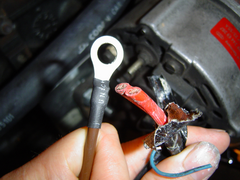scoobyis2cool
|
| posted on 3/6/04 at 12:01 PM |

|
|
Alternator wires
I'm just wiring up my alternator to my loom and have noticed that the alternator has 2 wires used for the charging circuit. My loom only has one
wire and it appears to be the same size as the wires from the alternator. Can I just wire up one of the wires from the alternator and leave the other
one or do I need to attach them both?
This is a photo of the wires, the red ones are from the alternator and the one with the loop connector is on my loom
Cheers,
Pete
Also, can anyone explain why the alternator has two large wires while my loom only has one? Does this mean that one of the alternator wires is
effectively redundant? I assume one wire will be able to cope with the current OK?
[Edited on 3/6/04 by scoobyis2cool]
 
Rescued attachment alternator wires.jpg
It's not that I'm lazy, it's that I just don't care...
|
|
|
|
|
JoelP
|
| posted on 3/6/04 at 12:25 PM |

|
|
sierra uses two smaller wires instead of one larger one because two wires will be more flexible. I would not be sure that one wire alone could carry
the full load, though admittedly a kit car will put less pressure on it. compare the loom wires size to the sum of the two wires, if the loom is
smaller then i presume it will cope.
|
|
|
scoobyis2cool
|
| posted on 3/6/04 at 12:36 PM |

|
|
quote:
Originally posted by JoelP
I would not be sure that one wire alone could carry the full load, though admittedly a kit car will put less pressure on it.
Looking at them the loom wire looks to be the same size as one wire from the alternator, so effectively I only have half the current-carrying
capability. I suppose the kit car does have a lot less to deal with - no interior lights, radio, heater, wipers etc, so I guess I'll just have
to suck it and see!
Pete
It's not that I'm lazy, it's that I just don't care...
|
|
|
scoobyis2cool
|
| posted on 3/6/04 at 12:38 PM |

|
|
I'm not entirely sure how an alternator works - does it try to "push" as much current down the wires as it can produce, or will it
wait for something to demand current (lights etc) before passing anything. If it works by the second method then I would have thought the single wire
would be OK since there are so few electrical items on my car
Cheers
Pete
It's not that I'm lazy, it's that I just don't care...
|
|
|
JoelP
|
| posted on 3/6/04 at 12:40 PM |

|
|
i think it is the second: the more you draw (ie lower resistance), the harder it is to turn. so it makes what is required to maintain 14 odd volts.
IMHO anyway
|
|
|
stephen_gusterson
|
| posted on 3/6/04 at 01:47 PM |

|
|
Joel is correct.
An alternator will try and supply a charging voltage of approx 13.8 - 14.4 or summat like that.
Effectively, the alternator and battery are in parallel, so BOTH will try and supply the load, to some extent.
The alternator will regulate charge to suit the load. If it didnt it would cook the battery big time. A 80-100a full on charge wouldnt be nice.
I recon that you may get away with a single core, - but they do look a bit whimpish - a safer way would be to go to a scrappy, and get a length of
cable with the right ends on it from a ford of similar.
atb
steve
[Edited on 3/6/04 by stephen_gusterson]
|
|
|
MK7
|
| posted on 11/6/04 at 11:07 PM |

|
|
I had a chat with the manufacturers of my wiring harness and they told me that the issue which constrained the type of wire had more to do with the
insulator used than with the diameter of the conductor...
Modern insulators can tolerate a greater heating effect than the older types, as a consequence it is feasible to use a narrower diameter conductor
with a modern insulater than what may have been acceptabe in the past.
Regarding the amount of current passing through the alternator cable, current only flows when there is demand so it's OK to think that the
battery will supply current to the various units (Lights, ignition, cooling fan etc...) and the alternator will supply current to the battery only
when it needs it.
HTH
|
|
|













